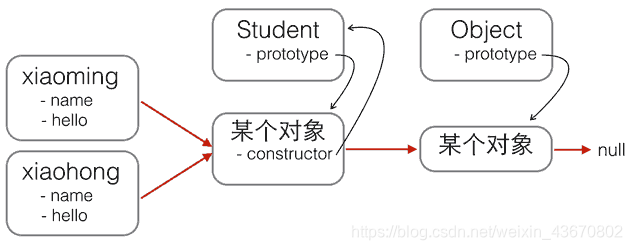摘自:廖雪峰老师的JS教程
简介
JavaScript不区分类和实例的概念,而是通过原型(prototype)来实现面向对象编程。
这是与其他编程语言的区别(比如Java)。
创建对象
JavaScript对每个创建的对象都会设置一个原型,指向它的原型对象。
逐层查找
当我们用obj.xxx访问一个对象的属性时,JavaScript引擎先在当前对象上查找该属性,如果没有找到,就到其原型对象上找,如果还没有找到,就一直上溯到Object.prototype对象,最后,如果还没有找到,就只能返回undefined。
例如,创建一个Array对象:
var arr = [1, 2, 3];
其原型链是:
arr ----> Array.prototype ----> Object.prototype ----> null
Array.prototype定义了indexOf()、shift()等方法,因此你可以在所有的Array对象上直接调用这些方法。
函数的原型链
当我们创建一个函数时:
function foo() {
return 0;
}
函数也是一个对象,它的原型链是:
foo ----> Function.prototype ----> Object.prototype ----> null
由于Function.prototype定义了apply()等方法,因此,所有函数都可以调用apply()方法。
很容易想到,如果原型链很长,那么访问一个对象的属性就会因为花更多的时间查找而变得更慢,因此要注意不要把原型链搞得太长。
构造函数
除了直接用{ ... }创建一个对象外,JavaScript还可以用一种构造函数的方法来创建对象。它的用法是,先定义一个构造函数:
function Student(name) {
this.name = name;
this.hello = function () {
alert('Hello, ' + this.name + '!');
}
}
这确实是一个普通函数,但是在JavaScript中,可以用关键字new来调用这个函数,并返回一个对象:
var xiaoming = new Student('小明');
xiaoming.name; // '小明'
xiaoming.hello(); // Hello, 小明!
注意:如果不写new,这就是一个普通函数,它返回undefined。但是,如果写了new,它就变成了一个构造函数,它绑定的this指向新创建的对象,并默认返回this,也就是说,不需要在最后写return this;。
新创建的xiaoming的原型链是:
xiaoming ----> Student.prototype ----> Object.prototype ----> null
也就是说,xiaoming的原型指向函数Student的原型。如果你又创建了xiaohong、xiaojun,那么这些对象的原型与xiaoming是一样的:
xiaoming ↘
xiaohong -→ Student.prototype ----> Object.prototype ----> null
xiaojun ↗
用new Student()创建的对象还从原型上获得了一个constructor属性,它指向函数Student本身:
xiaoming.constructor === Student.prototype.constructor; // true
Student.prototype.constructor === Student; // true
Object.getPrototypeOf(xiaoming) === Student.prototype; // true
xiaoming instanceof Student; // true

红色箭头是原型链。注意,Student.prototype指向的对象就是xiaoming、xiaohong的原型对象,这个原型对象自己还有个属性constructor,指向Student函数本身。
另外,函数Student恰好有个属性prototype指向xiaoming、xiaohong的原型对象,但是xiaoming、xiaohong这些对象可没有prototype这个属性,不过可以用__proto__这个非标准用法来查看。
对象
__proto__属性的值就是它所对应的原型对象:
详情查阅:https://www.jianshu.com/p/184d325e34a6
var a = {x: 1};
var b = new Object();
a.__proto__ === Object.prototype // true
b.__proto__ === Object.prototype // true
one.toString === one.__proto__.toString // true
对象都有
__proto__属性来标识自己所继承的原型,只有函数才有prototype属性。
现在我们就认为xiaoming、xiaohong这些对象“继承”自Student。
不过还有一个小问题,注意观察:
xiaoming.name; // '小明'
xiaohong.name; // '小红'
xiaoming.hello; // function: Student.hello()
xiaohong.hello; // function: Student.hello()
xiaoming.hello === xiaohong.hello; // false
xiaoming和xiaohong各自的name不同,这是对的,否则我们无法区分谁是谁了。
xiaoming和xiaohong各自的hello是一个函数,但它们是两个不同的函数,虽然函数名称和代码都是相同的!
如果我们通过new Student()创建了很多对象,这些对象的hello函数实际上只需要共享同一个函数就可以了,这样可以节省很多内存。
要让创建的对象共享一个hello函数,根据对象的属性查找原则,我们只要把hello函数移动到xiaoming、xiaohong这些对象共同的原型上就可以了,也就是Student.prototype:

修改代码如下:
function Student(name) {
this.name = name;
}
Student.prototype.hello = function () {
alert('Hello, ' + this.name + '!');
};
小结
不要忘记写new,另外构造函数一般首字母大写,方便编译器识别提示。
最后,我们还可以编写一个createStudent()函数,在内部封装所有的new操作。一个常用的编程模式像这样:
function Student(props) {
this.name = props.name || '匿名'; // 默认值为'匿名'
this.grade = props.grade || 1; // 默认值为1
}
Student.prototype.hello = function () {
alert('Hello, ' + this.name + '!');
};
function createStudent(props) {
return new Student(props || {})
}
我的实验
<!DOCTYPE html>
<html>
<head>
<meta charset="utf-8">
<title>JavaScript测试</title>
<script type="text/javascript">
'use strict';
function Person(name,age){
this.name=name;
this.age=age;
Person.prototype.eat=function(){
alert(this.name+'今年'+this.age+'岁了!');
var that=this;//解决this undefined
(function(){console.log(that.name);})();
}
}
var a=new Person('小明',23);
var b=new Person('小红',20);
a.eat();
b.eat();
console.log(a.eat===b.eat);//true
</script>
</head>
<body>
</body>
</html>